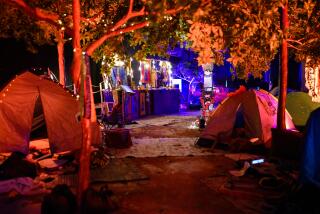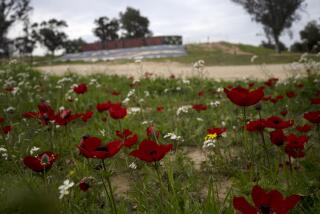Focus on Israel : Photo show gives panoramic picture of the nation through an American filter.
- Share via
As part of its celebration of Israel’s 50th anniversary, the Skirball Cultural Center put together an exhibit that, on paper, appears contrived. But in the end, “Israel Through American Eyes: A Century of Photography” manages to make pragmatic and even poetic sense of its thematic threads. It combines the history of the medium, the objective and sometimes impassioned observations of camera-wielding American visitors and Israel’s youthful statehood into one felicitous curatorial package.
The most contemporary work of the show comes at the tail end of the exhibition, where Margalit Mannor shows recent pieces in a series called “Return Address; Revisiting Exposures.” Juxtaposing vintage postcards from Israel with visual effects, she reflects on both her lingering bond with Israel and the frozen-time quality of photography--even the kitschy realm of postcard photography.
In what could be the exhibition’s central credo, she writes, “Israel is not a place or a time but the crossroads of both.”
History leaps back and forth in this exhibition, which is part of its inherent theme. Mannor’s work, more conceptual than other work in the show, provides a neat historical link to the earliest photography on view here, from around the turn of the century. At that time, the converging popularity of amateur photography and tourism in Palestine began a long tradition of photography from this exotic, spiritually charged juncture in the world.
Photojournalists also found natural intrigue in Israel, mining the cultural riches as well as the purely visual appeal of this uniquely old/new terrain. Max Yavno reveals his telling, perceptive eye for composition, with poise and also a flair for ironic drama. Compositionally, “Noon Prayer,” a street scene shot from overhead, is crisply divided into three horizontal bands: buildings on top, traffic on the bottom and, in the middle, an orderly crowd of faithful supplicants bowing in prayer on the sidewalk.
Yavno’s “Wailing Wall, Men’s Section” depicts two black-clad, bearded Orthodox Jews in contrast to two trim, clean-shaven soldiers, with the venerable, thickly textured wall in the background, transcending--or ignoring--differences of fashion or culture.
Famed photojournalist Robert Capa is also well-represented in the show, with seven images from his series documenting Israel’s momentous birth. These are mostly images of hope and renewal, as with the meaningful shot of a French emigre tilting across the picture frame, leaning on a shovel, tilling new soil to start a vineyard. In a strange visual echo, the composition recalls Capa’s famous picture “Moment of Death,” in which a soldier in the Spanish Civil War has just taken a bullet and is tilting backward. But the message in the Israeli photograph is the antithesis: the moment of birth.
Another slice of photographic, and personal, history comes courtesy of Roman Freulich, who photographed the Palestine landscape in 1918, and then returned to Israel 50 years later. In the interim, Freulich made a name for himself in Hollywood as a portrait photographer to the stars. His sensitive studies of Israelis, humbly engaged in a simpler life, reflects the opposite side of the world both culturally and geographically.
Arthur Ollman visited Jerusalem as part of a project to capture imagery of the city when it turned 3,000. Deep color and long exposures by night give his shots of ancient walls an enchanted air.
From another architectural angle entirely, Judith Turner’s austere visual editing and use of black and white on modern-day Tel Aviv clarify and reinvent form.
Los Angeles-based photographer Marvin Rand shows a very different and more humanity-oriented Tel Aviv. On the anniversary of Prime Minister Yitzhak Rabin’s assassination, during the ritual known as the “yahrzeit,” masses of candles and gathering mourners signify collective grief.
In all, this show effectively gives a sense of inspiring and conflicting impressions of Israel, through American eyes. These photographers recognize, in various ways, that Israel is a land, unique in the world, where displacement and rebirth go hand in hand toward an uncertain, but passionate, future.
BE THERE
“Israel Through American Eyes: A Century of Photography,” at the Skirball Cultural Center, 2701 Sepulveda Blvd. in Los Angeles. Tuesdays-Fridays, 10 a.m.-4 p.m.; Saturdays, noon-5 p.m.; Sundays, 10 a.m.-5 p.m. Ends Jan. 3. (310) 440-4500.
More to Read
The biggest entertainment stories
Get our big stories about Hollywood, film, television, music, arts, culture and more right in your inbox as soon as they publish.
You may occasionally receive promotional content from the Los Angeles Times.










